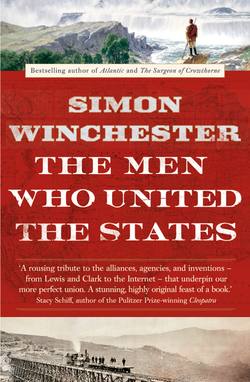Читать книгу The Men Who United the States: The Amazing Stories of the Explorers, Inventors and Mavericks Who Made America - Simon Winchester, Simon Winchester - Страница 20
HIGH PLAINS RAFTERS
ОглавлениеWhen the winter broke and the prairie ice had begun to melt, the party set off again. They sent their big iron boat back downriver, laden with reports, specimens,9 and booty for the White House. But in their two original pirogues, together with half a dozen newly made cottonwood canoes, Lewis and Clark, along with most of their soldiery, their new interpreters, and Sacagawea and Pomp, set off upstream. It was April 7, 1805.
There was a general mood of excitement and no little regret at leaving, even among the men. During the previous six months, there had been plenty of sexual activity—the Mandan Indians were generous in offering their wives’ favors to the visitors, and the irritations of syphilis (with which many of the locals had been infected, reputedly by the French trappers) and the frequent need for mercury-ointment treatments were getting frankly tiresome. “We were now about to penetrate a country at least two thousand miles in width,” Meriwether Lewis wrote later, apparently without any intended punning, “on which the foot of civilized man had never trodden.”
At first there were many miles of loneliness and heartache—the plains desolate, the rivers shallow and fast with snowmelt, the winds “violent” and incessant, and the breath of Canada—for the territory they explored was just a few miles south of the present boundaries of Manitoba and Saskatchewan—intense and unpleasantly chill. Initially they did not encounter any Indians, other than a dead man they found on a specially built coffin-platform, offerings to the gods scattered beside him. But they did see a good deal of new wildlife: the terrifically dangerous and nearly unkillable grizzly bears most notably, as well as gophers, bald eagles, mule deer, bighorn sheep, prairie rattlesnakes, a kind of avocet, and a snipelike bird now called a willet.
There were new plants, too—such as the just-about-edible white-apple-like prairie turnip (which Sacagawea munched and seemed to enjoy) and in the drier plains the prickly pear, which painfully abraded the soldiers’ feet during the ever-more-necessary portages. And there were minerals, most especially long outcrops of the coal that is so important a part of the economy of the western plains today. The immense Union Pacific and BNSF coal trains that rumble along the horizons on their way out of the region today provide a visually appropriate kind of mobile legacy, a memorial to the expedition that first noted the wealth underground.
A month later the men, still on the ever-narrowing Missouri, were past the confluence with the Yellowstone River and two weeks later still were gliding through a peculiarly harsh landscape that is nowadays known as the Missouri Breaks, lying within the boundaries of the giant state of Montana. Lewis loved the place. His writings here were more cheerful and lyrical than at almost any other place in the odyssey. He even sees a peculiar beauty in the strange bleakness of the landscape, where the river twisted through the loneliness, with its white canyon cliffs speared through with dark patches of volcanic rocks that hint at the mountains that we now know are ahead. That the Breaks, a region so far away from the main western trails, a territory that is sparsely settled and has been largely unpopulated and unfarmed for most of its history, would later become infamous as a hiding place for outlaws and brigands only adds to an allure that Lewis can never have imagined.
Both Lewis and Clark believed that an immense range of mountains lay some way before them, and Clark first spied them from the Missouri Breaks. The distance had unrolled furiously in the weeks before: they had now done 2,387 miles since leaving Saint Louis. It was Sunday, May 26:
… assended a part of the plain elevated much higher … from this point I beheld the Rocky Mountains for the first time with Certainty.10 I could only discover a fiew of the most elevated points above the horizon. The most remarkable of which by my pocket Compas I found bore S.60W. Those points of the rocky Mountain were Covered with Snow and the Sun Shown on it in Such a manner as to give me a most plain and Satisfactory view. Whilst I viewed those Mountains I felt a Secret pleasure in find myself So near the head of the heretofore Conceived boundless Missouri.
Before they could reach the mountains, there were still many more days of difficult slogging—none more so than when they came to the Great Falls of the Missouri and had to portage around the rapids for the better part of a month. But by now the landscape was dramatically different from anything they had seen since coming through the Appalachians: up on the foothills there were trees again, and before long the foothills gave way to mountains, grander mountains than they had ever seen before. They would soon slice deep into them, and pass the Continental Divide, and begin their steady drop down to the ocean they knew on the far side.
